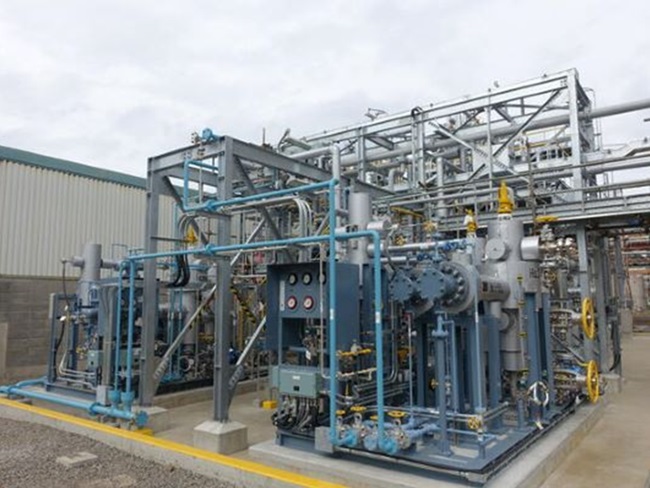Context:
Recently, the National Thermal Power Corporation (NTPC) inaugurated the World’s first CO₂-to-methanol conversion plant in Pune, Maharashtra.
About CO2 to Methanol Plant
The NTPC has also developed and tested the ‘first indigenous catalyst’ for Methanol Synthesis and made substantial progress with hydrogen, carbon capture, and other innovative technologies.
The conversion of CO2 to methanol is a process known as CO2 reduction and involves the following steps:
- Capture and purification of CO2: CO2 is captured from industrial processes or directly from the air, and then purified to remove impurities.
- Production of low-carbon-intensity hydrogen: It is initially from the reforming of methane with carbon capture, but over time, increasingly from the electrolysis of water using renewable electricity from solar, wind or hydroelectricity.
- Conversion of CO2 to carbon monoxide (CO): CO2 is reacted with hydrogen gas (H2) to produce carbon monoxide (CO) and water (H2O). This is known as the reverse water-gas shift reaction.
- Conversion of CO to methanol: The CO produced in the previous step is then reacted with hydrogen in the presence of a catalyst to produce methanol (CH3OH).
About Carbon, Capture and Utilization (CCU)
It involves capturing carbon dioxide (CO2) and using it in different ways:
- CO2 can be used without any chemical changes, such as in the fertilizer industry.
- CO2 can be transformed into other products, like synthetic fuels and chemicals.
Pinaka Rocket System
Context:
The French Army evaluating India’s indigenous Pinaka multi-barrel rocket launcher (MBRL) system for its potential use by their armed forces.
About Pinaka Rocket System
- The Pinaka rocket system, named after Lord Shiva’s divine bow, gained its first combat experience in the 1999 Kargil conflict against Pakistan.
- It was developed by the Pune-based Armament Research and Development Establishment (ARDE), an important arm of the Defence Research and Development Organisation (DRDO).
Features of the system
Variants:
- Mk-I: 37.5 km (23.3 mi)
- Mk-I Enhanced: 45 km (28 mi)
- Mk-II: 60 km (37 mi)
- Guided Pinaka: 75 km (47 mi)
- ERR 122: 40 km (25 mi) (testing phase)
- Mk-II ER: 90 km (56 mi) (testing phase)
- Mk-III: 120 km (75 mi) (under development)
- Mk-III ER: 300 km (190 mi) (under development)
Launch System: Typically consists of a truck-mounted platform with multiple launch tubes, allowing for quick redeployment. Rockets can be fired individually or simultaneously in different directions.
Guidance: Uses both unguided and guided rockets, providing versatility in targeting. The navigation system of the missile is linked with the Indian Regional Navigation Satellite System.
Project ‘Shaurya Gatha’
Context:
Recently, The Chief of Defence Staff (CDS) launched Project ‘Shaurya Gatha’ to conserve and promote India’s military heritage through education and tourism.
About Project ‘Shaurya Gatha’
- It is an initiative that focuses on honouring and preserving the legacy of Indian Armed Forces personnel, especially their sacrifices and contributions.
- Collaboration: It is an initiative of the Department of Military Affairs with the collaboration of the United Service Institution (USI) of India.
- Aim: To highlight the valour, bravery, and stories of soldiers through various channels.
- Purpose: To celebrate the courage and sacrifice of Indian Armed Forces personnel, particularly those who have laid down their lives for the country.
- Scope: Covers stories from soldiers across all branches of the military, including the Army, Navy, Air Force, and paramilitary forces.
- Mediums: Utilizes books, documentaries, and online platforms to spread awareness about these heroics.
- Educational Value: Aims to educate the younger generation about the true essence of patriotism, selflessness, and national duty.
- Community Involvement: Encourages public participation in the form of tributes, stories, and commemorative events.
- National Impact: Inspires a sense of pride and respect for the military and its enduring role in securing the nation’s freedom.
Indian Military Heritage Festival (IMHF)
- It is a flagship annual event organized by the USI of India through its Center for Military History and Conflict Studies (CMHCS).
- The festival aims to increase public awareness of India’s military traditions and strategic priorities.
- The first annual IMHF was held in October 2023 at the Manekshaw Centre in New Delhi.

